by Jenny Golding
 On a clear night in July, dozens of park visitors are standing in the dark at a large pullout along the road between Mammoth Hot Springs and Tower Junction—staring up at the sky. Overhead, the Milky Way splashes across the heavens in a seemingly impossible river of stars. National Park Service (NPS) Interpretive Ranger Tammi Corchero uses a green laser pointer to highlight constellations, nebulae, galaxies, and other celestial features. Nearby, visitors peer through a telescope fixed on Saturn. At this Star Party, a summer interpretive program offered by Yellowstone National Park, the mood is one of awe. “Most people come from places where they don’t have dark night skies…. They’re just amazed at what they see,” says Corchero. “I’ve seen people come to tears when they see the Milky Way for the first time.”
On a clear night in July, dozens of park visitors are standing in the dark at a large pullout along the road between Mammoth Hot Springs and Tower Junction—staring up at the sky. Overhead, the Milky Way splashes across the heavens in a seemingly impossible river of stars. National Park Service (NPS) Interpretive Ranger Tammi Corchero uses a green laser pointer to highlight constellations, nebulae, galaxies, and other celestial features. Nearby, visitors peer through a telescope fixed on Saturn. At this Star Party, a summer interpretive program offered by Yellowstone National Park, the mood is one of awe. “Most people come from places where they don’t have dark night skies…. They’re just amazed at what they see,” says Corchero. “I’ve seen people come to tears when they see the Milky Way for the first time.”
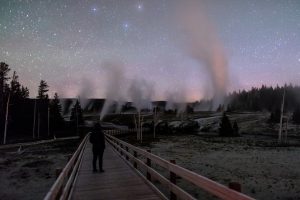 For millennia, the night sky has been an important source of inspiration, reflection, and scientific discovery. As recent as 100 years ago, children and adults alike could gaze up at the sky as their ancestors did, swallowed in the endless complexity of the stars, and ponder the mysteries of the universe. Today, artificial light from developed areas—hundreds of times brighter than natural night sky—creates a form of light pollution known as skyglow, concealing the stars for up to 100 miles. A recent study in Science Advances reports that light pollution obscures the heavens for 99 percent of the people in North America and Europe. Fully one-third of the world’s population can no longer see the Milky Way.
For millennia, the night sky has been an important source of inspiration, reflection, and scientific discovery. As recent as 100 years ago, children and adults alike could gaze up at the sky as their ancestors did, swallowed in the endless complexity of the stars, and ponder the mysteries of the universe. Today, artificial light from developed areas—hundreds of times brighter than natural night sky—creates a form of light pollution known as skyglow, concealing the stars for up to 100 miles. A recent study in Science Advances reports that light pollution obscures the heavens for 99 percent of the people in North America and Europe. Fully one-third of the world’s population can no longer see the Milky Way.
The spread of light pollution is altering the natural rhythm of light and dark that has governed life on earth for billions of years. According to the International Dark-Sky Association (IDA), light pollution has serious, detrimental effects for both humans and animals—disrupting circadian rhythms, melatonin, and sleep patterns in humans and interrupting breeding, migration, and hunting in animals, birds, and insects.
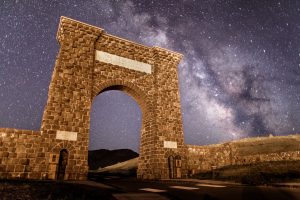 Fortunately, darkness still reigns in Yellowstone, where the park protects a sky wilderness of staggering beauty. Limiting the amount of light pollution that comes from developed areas is key to ensuring that it stays that way for generations to come. “Yellowstone is an ecosystem,” says park landscape architect Lynn Chan. “That ecosystem functions during the day, as well as at night.” While the handful of developed areas in the park are “small villages in the vast wilderness,” says Chan, they contain more than 5,000 individual outdoor light fixtures and lamps. “It’s one of those impacts to wilderness that we can mitigate very easily. All we have to do is turn off or change the light.”
Fortunately, darkness still reigns in Yellowstone, where the park protects a sky wilderness of staggering beauty. Limiting the amount of light pollution that comes from developed areas is key to ensuring that it stays that way for generations to come. “Yellowstone is an ecosystem,” says park landscape architect Lynn Chan. “That ecosystem functions during the day, as well as at night.” While the handful of developed areas in the park are “small villages in the vast wilderness,” says Chan, they contain more than 5,000 individual outdoor light fixtures and lamps. “It’s one of those impacts to wilderness that we can mitigate very easily. All we have to do is turn off or change the light.”
Artificial light exists on a color spectrum. Lights in the blue spectrum—4,000 Kelvin or higher—mimic daylight and refract light into the sky more easily. Yellow and amber lights—around 3,000K or less—have a much lower impact on the night environment. Protecting the night sky also means ensuring that outdoor lights illuminate only where needed, are no brighter than necessary, and are fully shielded (with fixtures pointing downward instead of up and out). In Yellowstone, many of the fixtures in villages like Old Faithful, Mammoth Hot Springs, and Lake Village have been custom-designed by Chan and park electricians to match the historic character while also minimizing light pollution.
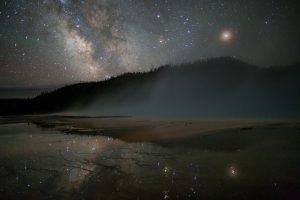 Yellowstone is working towards becoming a “Dark Sky Park”—an IDA designation that recognizes places that protect the night sky by meeting national standards for shielding, color spectrum, and developing public education programs. While the park has been changing outdoor lights for 20 years—when funding is available—there’s still plenty of work to do. A recent inventory of outdoor lighting in the park conducted by Ohio Northern University revealed roughly 2,500 non-compliant light fixtures across NPS and concessionaire facilities. The park will have to reach at least 67 percent compliance to become eligible for “Dark Sky” status.
Yellowstone is working towards becoming a “Dark Sky Park”—an IDA designation that recognizes places that protect the night sky by meeting national standards for shielding, color spectrum, and developing public education programs. While the park has been changing outdoor lights for 20 years—when funding is available—there’s still plenty of work to do. A recent inventory of outdoor lighting in the park conducted by Ohio Northern University revealed roughly 2,500 non-compliant light fixtures across NPS and concessionaire facilities. The park will have to reach at least 67 percent compliance to become eligible for “Dark Sky” status.
At the Star Party, Corchero points out the Andromeda Galaxy. The closest large galaxy to our own, Andromeda is still 2.5 million light years away, and is only one of billions of galaxies. On a good night 5,000–6,000 stars are visible to the naked eye in our neighborhood of the Milky Way, out of a staggering one sextillion stars in the observable universe.
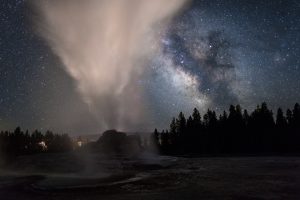 “Can you imagine a world where we couldn’t see this?” says Corchero as she talks about easy ways visitors can help mitigate light pollution at home (such as by closing blinds at night and making sure outdoor lights are properly shielded). “We would lose this incredible source of beauty and inspiration. If we didn’t know what was up there, there’s so much we wouldn’t understand about the universe.”
“Can you imagine a world where we couldn’t see this?” says Corchero as she talks about easy ways visitors can help mitigate light pollution at home (such as by closing blinds at night and making sure outdoor lights are properly shielded). “We would lose this incredible source of beauty and inspiration. If we didn’t know what was up there, there’s so much we wouldn’t understand about the universe.”
HOW TO VIEW the Night Sky in Yellowstone
- Get away from lights. Find a quiet spot away from developed areas, such as Lamar Valley, Swan Lake Flat, or Hayden Valley.
- Protect your night vision. Use a headlight or flashlight with a red bulb, or put red cellophane over your light.
- Pick up a copy of our Night Sky Folding Pocket Guide available at online at our Yellowstone Forever Park Store.
- Learn a little at a time. Learn a new constellation, nebula, or planet every time you go out. Soon, you’ll amaze yourself and your friends with how much you know.
- Take a class or program. Participate in a star party offered by the NPS; take the Yellowstone Forever Field Seminar Time Lapse and Night Photography; or join the Stars over Yellowstone program offered by NPS and Museum of the Rockies. For more information, visit Yellowstone.org and nps.gov/yell.
This article was originally published in the Summer 2018 issue of Yellowstone Quarterly.
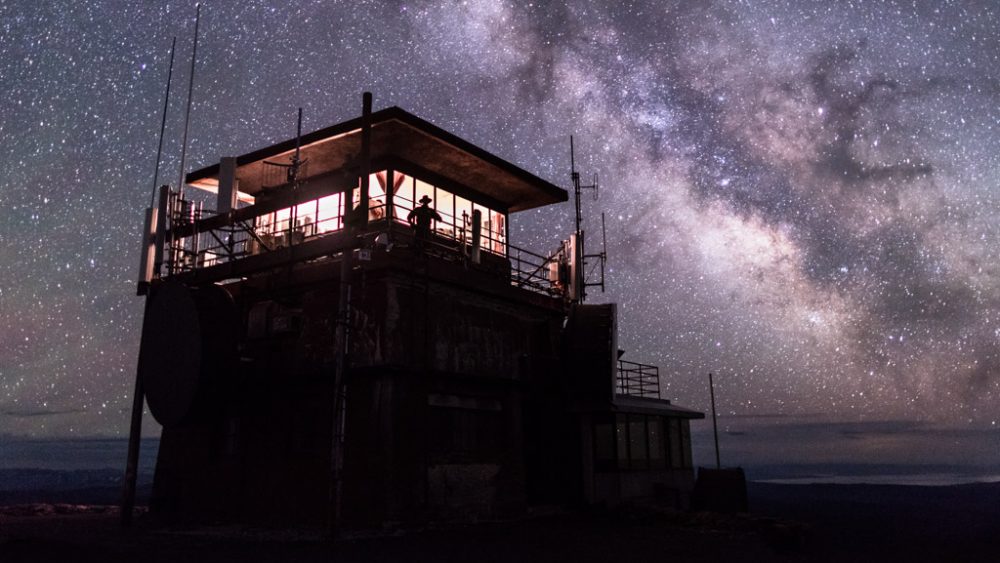
Comments are closed.